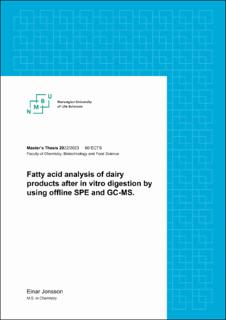| dc.description.abstract | Dairy products are an essential source of nutrition in Nordic diets. Lipids are a substantial part of bovine milk and a vital energy source, as well as providing physiological components in enzymes and immune systems, hormones and vitamins. Lipids are arranged mostly into triacylglycerols (TAG), containing three fatty acids (FA) in ester bonds to a glycerol moiety. TAGs hydrolyse into monoacylglycerols (MAG) and free fatty acids (FFA) by digestive enzymes before uptake in the stomach and small intestine. The arrangement of FAs on the glycerol in TAG affect their physical/chemical properties, absorption and health effects.1 The Norwegian Center for Research-based Innovation (CFI) funds the “Foods of Norway” research project, aimed at developing technologies within agriculture and aquaculture. LipidInflammaGenes is a part of this project and aims at investigating the structure and composition of triacylglycerols in dairy lipids and their effect on digestibility and inflammation. This thesis will identify and quantify FAs in 2-MAG of digested dairy products.
A static in vitro digestive model (INFOGEST) containing an array of digestive enzymes is employed in digesting four independent dairy products; gouda cheese (Norvegia), cream cheese (kremgo), whole cream (kremfløte) and sour cream (seterømme). The lipids are extracted from the digestion matrix using Folch's extraction. The extracted lipids are separated into polar lipids (PL), FFA and neutral lipids (NL) using automated offline solid phase extraction (SPE). The NL fraction is further split into TAG, diacylglycerol (DAG), and MAG by the same method. Transesterification then derivates each fraction into its corresponding fatty acid methyl ester (FAME). FAMEs are analysed using GC-MS. The Glycerol content for each sample is analysed using a Megazyme® glycerol assay kit.
The stereospecificity of digestive enzymes ensures that fatty acids attached in the sn-2 position on the TAG are not hydrolysed; the MAG fraction will reveal the FA composition in this position and is the focus of this investigation.
This investigation has identified 47 unique fatty acids, of which 36 have been quantified. Undigested dairy products concur well with previous reports on milk lipids and show 70 % saturated fatty acids (SFA), 30 % mono-unsaturated fatty acids (MUFA) and 1 – 2 % poly-unsaturated fatty acid (PUFA). In addition, FA profiles are almost identical for each dairy product with C16:0 (33 – 36 %), C18:1c9 (23 – 26 %), C18:0 (16 – 17 %), C14:0 (9 – 10 %) and C12:0 (2 – 3 %). MAG analysis shows 77 % SFA, 21 % MUFA and 1 % PUFA. Compared to the undigested, MAG has a relative increase in C16:0 and C14:0 (12 % and 8 % larger, respectively) with a simultaneous decrease in C18:1c9 and C18:0 (8 % and 10 % smaller, respectively). The greatest difference was in C18:0 concentration, which had halved. The MAG analysis showed no short-chain fatty acids (SCFA) presence. These results concur well with previous reports on TAG structure in bovine milk, which suggests that SCFAs are attached in the sn-3 position, C18:0 and C18:1c9 are preferentially attached in the sn-1 or sn-3 position, and long-chain fatty acids are attached in the sn-2 position. This concurrence with TAG structures in undigested whole milk suggests that the effect of fermentation, processing and digestion is minimal to the structure of TAG. Glycerol analysis shows free glycerol in digested samples, indicating isomerization of 2-MAG into 1(3)-MAG, which digestive enzymes hydrolysed into free glycerol. Digested whole milk shows a substantial presence of free glycerol (10 %).
The FA analyses have good precision with minor standard deviations (<5 %). However, the analyses report a too high amount of FAs, especially for FFA fractions. This results from the internal standard (IS) concentration being lower than estimated, likely from evaporation or deposition from the solution. It is also known from previous FAME analysis that SCFAs are under-quantified because they are more volatile and polar, thus evaporating or extracting out of solution. These problems can be rectified by controlling the concentration of the IS before quantification and adding shorter IS (e.g. C5:0). Several factors influence variations in FA composition (season, genetics, feed, stage of lactation), which are difficult to control and complicates analysis. The In vitro digestion model does not remove products from solution, as it would In Vivo, and does not give an accurate representation of the reaction kinetics, as less product will be formed. | |
